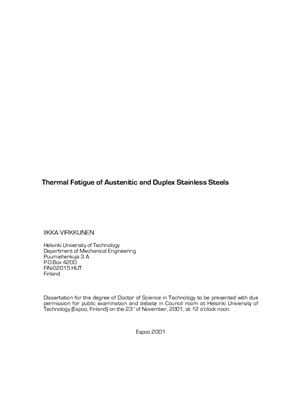Acta Polytechnica Scandinavica, Mechanical Engineering Series No.
154, Espoo 2001, 115 pp.
Published by the Finnish Academies of Technology
Helsinki University of Technology
Department of Mechanical Engineering
Puumiehenkuja 3 A
P.O.Box 4200
FIN-02015 HUT
Finland
Thermal fatigue behavior of AISI 304L, AISI 316, AISI 321, and AISI 347 austenitic stainless steels as well as 3RE60 and ACX-100 duplex stainless steels was studied. Test samples were subjected to cyclic thermal transients in the temperature range 20 – 600°C. The resulting thermal strains were analyzed with measurements and numerical calculations. The evolution of thermal fatigue damage was monitored with periodic residual stress measurements and replica-assisted microscopy. The elastic strains of the ferrite phase in duplex stainless steels were studied using Barkhausen noise. Finally, destructive analyses including fractographic scanning electron microscopy (SEM) studies and transmission electron microscopy (TEM) analyses were performed.
The surface residual stresses changed markedly during the first load cycles. In the austenitic stainless steels yielding during the rapid cooling resulted in compressive residual stresses from -200 MPa (20 – 300°C temperature cycle) to -600 MPa (20 – 600°C temperature cycle). After 10 cycles the residual stresses stabilized and then started to relax due to crack formation. Cracks were seen to initiate from persistent slip bands (PSBs) and in 3RE60 from MnS inclusions. In duplex stainless steels the phase boundaries retarded crack growth markedly.
In the austenitic stainless steels, the fracture surfaces of thermal fatigue cracks showed extensive striation formation, i.e. they were similar to mechanical fatigue. The dislocation density was lower than expected based on mechanical fatigue data. Dislocation tangles and occasional cell tendency was observed. In duplex stainless steels the plastic deformation concentrated to the austenite phase.
Published by the Finnish Academies of Technology
Helsinki University of Technology
Department of Mechanical Engineering
Puumiehenkuja 3 A
P.O.Box 4200
FIN-02015 HUT
Finland
Thermal fatigue behavior of AISI 304L, AISI 316, AISI 321, and AISI 347 austenitic stainless steels as well as 3RE60 and ACX-100 duplex stainless steels was studied. Test samples were subjected to cyclic thermal transients in the temperature range 20 – 600°C. The resulting thermal strains were analyzed with measurements and numerical calculations. The evolution of thermal fatigue damage was monitored with periodic residual stress measurements and replica-assisted microscopy. The elastic strains of the ferrite phase in duplex stainless steels were studied using Barkhausen noise. Finally, destructive analyses including fractographic scanning electron microscopy (SEM) studies and transmission electron microscopy (TEM) analyses were performed.
The surface residual stresses changed markedly during the first load cycles. In the austenitic stainless steels yielding during the rapid cooling resulted in compressive residual stresses from -200 MPa (20 – 300°C temperature cycle) to -600 MPa (20 – 600°C temperature cycle). After 10 cycles the residual stresses stabilized and then started to relax due to crack formation. Cracks were seen to initiate from persistent slip bands (PSBs) and in 3RE60 from MnS inclusions. In duplex stainless steels the phase boundaries retarded crack growth markedly.
In the austenitic stainless steels, the fracture surfaces of thermal fatigue cracks showed extensive striation formation, i.e. they were similar to mechanical fatigue. The dislocation density was lower than expected based on mechanical fatigue data. Dislocation tangles and occasional cell tendency was observed. In duplex stainless steels the plastic deformation concentrated to the austenite phase.

